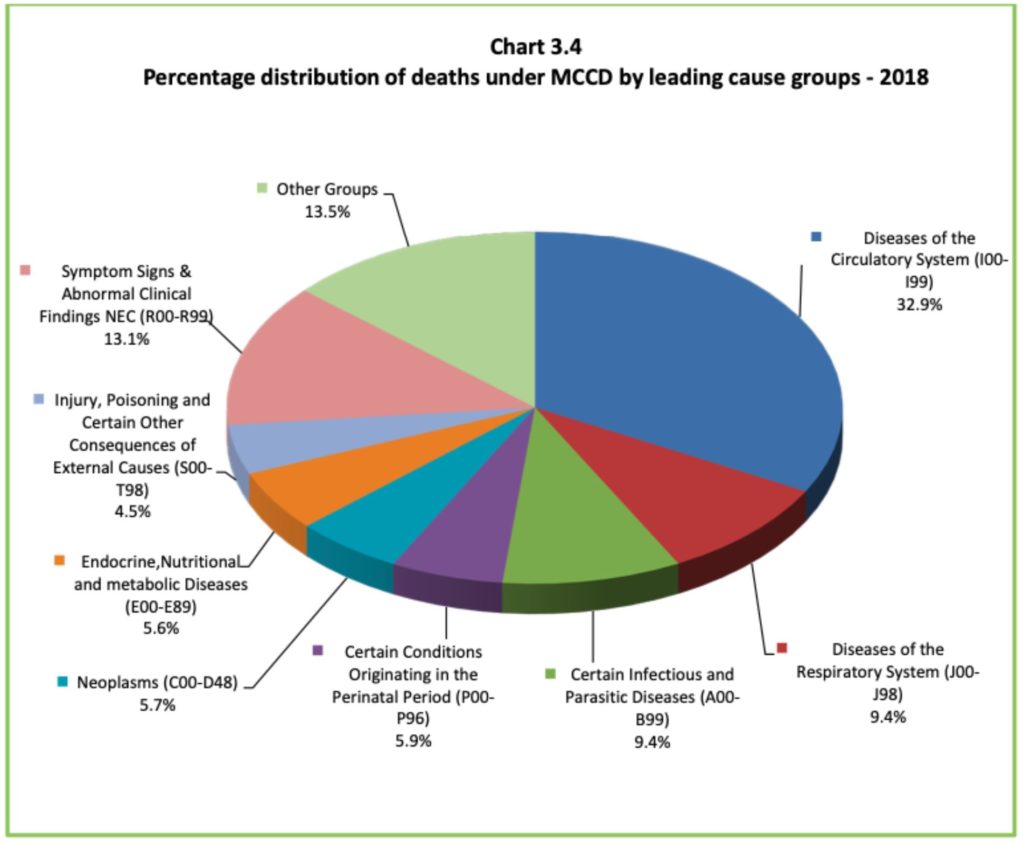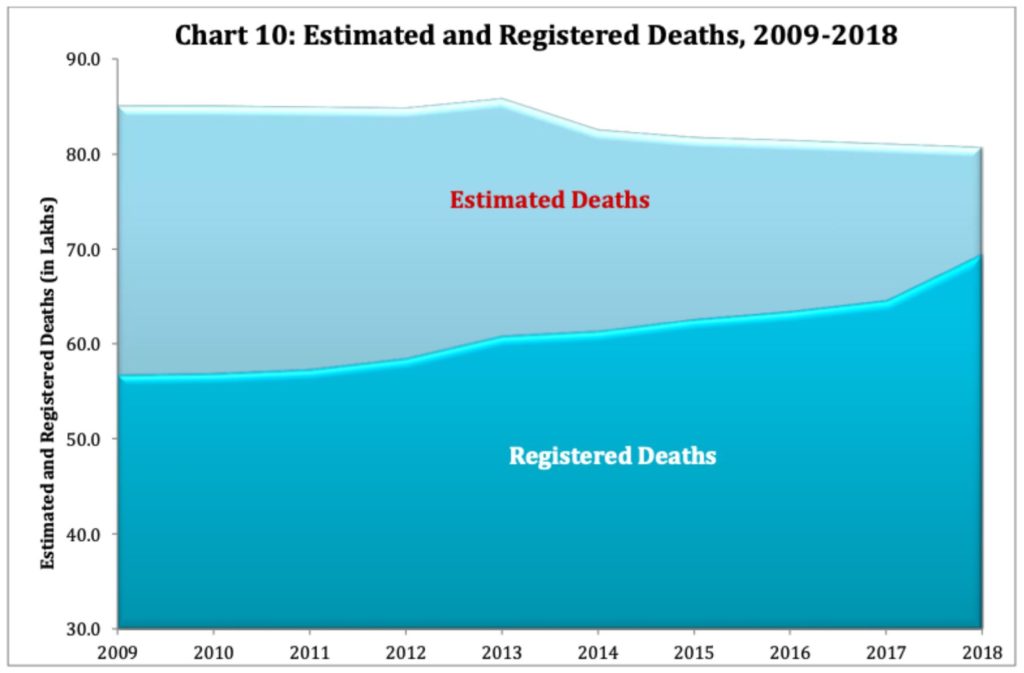The latest 2018 report of the ‘Civil Registration System’ and ‘Medically Certified Deaths’ indicate that the death registration rate in India increased to over 80% in 2018 while the medically certified deaths continue to be much lower. Here is a review.
As per the daily update provided by the Ministry of Health & Family Welfare (MoHFW), there were over 2 thousand COVID-19 related deaths reported on 21 April 2021. Since the beginning of the COVID-19 pandemic in the country, over 1.84 lakh deaths have been reported in India due to COVID-19. During the first wave of COVID-19 infection in the country, the fatality rate in India has been among the least in the world. While the fatality rate is not alarmingly different in the second wave as yet, it is still early days in the second wave.
At the same time, there are claims of under-reporting of deaths from multiple sections of the media and by various organizations. An article in the financial times estimates that the actual deaths in a few cities could be 10 times more than what is officially reported.
In an earlier story, we have highlighted the general trend in the under-registration of the deaths in the country. While India is among the top-5 countries in terms of total COVID-19 related deaths, how do these deaths compare with the number of deaths that usually occur in India every year? We had earlier analysed the trends in the recording of deaths in the country based on official reports. Here is an analysis based on the latest available data.
Highest rate of increase in registered deaths in over 10-year period recorded in 2018.
Among other information, Vital Statistics of India based on the Civil Registration System report provides information about the registered deaths in the country. As per the latest report for the year 2018, around 69.5 lakh deaths were registered across the country in 2018. This is a 7.7% increase when compared to that of the 2017 number. A higher year-on-year increase was reported in 2007 when the number of registered deaths was 9.1% more than in 2006.
In the earlier story, we had highlighted the lack of comprehensive information relating to mortality in India. The Civil Registration System, under which the births & deaths are registered is the most reliable source. However, the data reported by the system is largely dependent on the registration of births & deaths across the country.
The increase in the number of registered deaths in 2018 might not indicate an actual increase in the number of deaths as compared to the previous year but point to an increased awareness in getting the deaths registered. In fact, the 2018 report estimates the total deaths in the country at 80.77 lakh as compared to 81.17 lakh in 2017. In other words, there is an increase in the percentage of registered deaths in comparison with the estimated deaths in 2018 at 86% compared to 79.6 % in 2017.
Bihar, Jharkhand, U.P & Telangana along with most of North-Eastern States have a lower rate of Death registration
The level of registration of deaths has consistently increased over the years, as per the CRS report. In 2009, the rate of registration was 66.9% of the estimated deaths. This national figure has increased year on year to reach 86% in 2018. While there is a significant increase in the level of registration in India, it is not consistent across the states.
If one considers the 2018 figures of death registration, Andhra Pradesh, Gujarat, Haryana, Karnataka, Kerala, Odisha, Punjab & Tamil Nadu are among the larger states which have a 100% death registration rate i.e., the number of deaths registered in the respective states is on par or more than the estimated deaths, as per the CRS report. The registration rate has been higher and consistent in these states even during the previous years.
Meanwhile, only 34.6% of estimated deaths were registered in Bihar during 2018. In the earlier year, it was only 42.7%. A total of 60.8% of the estimated deaths were registered in Uttar Pradesh in 2018. Although it is still among the least in larger states, there is a significant improvement compared to 38.3% in 2017. Over the period of 2009-2016, the registration rate in U.P was mostly in the range of 40-50%.
In 2018, Telangana has registered only 58.2% of the estimated deaths, which is lower than its usual rate of more than 75% in the previous years. Jharkhand is another state with a relatively lower death registration rate. The north-eastern states of Tripura, Sikkim & Mizoram have 100% death registration rates whereas the rates are much lower in other north-eastern States.
None of the major states reported more than 45% of the registered deaths as Medically Certified deaths.
In an earlier story, we highlighted that only a limited number of hospitals are covered under the Medical Certification of Cause of Death scheme (MCCD). In 2017, there were 58,240 such institutions whereas as per a report on ‘Medical Certification of Cause of Death-2018’, the number of such institutions was only 57.1 thousand. This could be due to few states not providing the details.
As per the information provided in the 2018 report, only 21% of the total registered deaths are MCDs (Medically Certified Deaths) in 2018. This is lower than that of 2017 when this was 22%. As with the case of the death registration rate, there are variations among the states. But as a general trend, the share of MCDs is lower among most of the major states compared to the rate of registration. Tamil Nadu is the highest among the bigger states with 45% of registered deaths being Medically certified. Jharkhand & Uttar Pradesh are at the bottom with only 4.6% & 5.1% of the registered deaths being medically certified.
Diseases of Circulatory System form the major portion of MCDs
In 2018, out of the total Medically Certified deaths, 4.78 lakh deaths i.e., 32.9% were due to diseases related to the ‘Circulatory System’. This forms a major part of the MCDs. Even in the previous years, the proportion of deaths due to diseases of ‘Circulatory System’ are higher compared to the other categories.
Around 1.36 lakh i.e., 9.4% of MCDs are due to diseases of the ‘Respiratory system’ in 2018. Roundabout the same proportion is the MCDs because of ‘Certain infectious & Parasitic Diseases’.
Data over the years shows that while the proportion of MCDs due to ‘Respiratory System’ related diseases has remained the same, the share of MCDs due to ‘Certain infectious & Parasitic Diseases’ has come down. This share is being compensated by MCDs due to ‘Neoplasms’ or ‘Endocrine, Nutritional or Metabolic Diseases’. In terms of age group, a major portion of MCDs is of those above 70 years of age.

This data can be further corroborated with ‘Causes of Death Statistics’ available with Census India. As per the cause of Death 2010-2013 report, Cardio-Vascular & Respiratory diseases are the two major causes of the surveyed deaths in India.
Lack of provision to determine the co-morbidity for COVID-19 related deaths
As per the available information regarding mortality in India, it can be ascertained that:
- In spite of the improvement in the death registration rate, the registered deaths compared to estimates are still less than 90%. The information is further compromised with the very low rates in a few of the large states.
- Even among the registered deaths, only a fraction are medically certified deaths, providing very little data/information on the cause of these deaths.
This ambiguity in terms of the actual cause can be seen in the case of COVID-19 deaths as well. Considering that the COVID-19 infection started to increase around March-April 2020, we can assume the end of March 2021 marks one full year of COVID-19 infections in India. As of 31 March 2021, over 1.62 lakh COVID-19 related deaths were reported in the country.
However, we do not have any comprehensive information on the co-morbidities which could have contributed to the death of COVID-19 infected patients. This information is crucial in understanding any relationship between the more prevalent causes of death in India and the COVID-19 related deaths. Lack of such information hampers any detailed analysis and healthcare planning. We had highlighted this concern in an earlier story, where the USA & European countries are being proactive in detailed reporting of COVID-19 related deaths.
Furthermore, the above-highlighted reasons for lower & inconsistent death reporting in India raise questions on the number of actual COVID-19 related deaths in the country. The higher number of COVID-19 deaths reported from states that generally have a higher Death registration rate, and lower COVID-19 deaths from a few of the states with lower registration rates raises questions on the veracity of COVID-19 death numbers in the country.
Featured Image: Death Registration Rates in India



